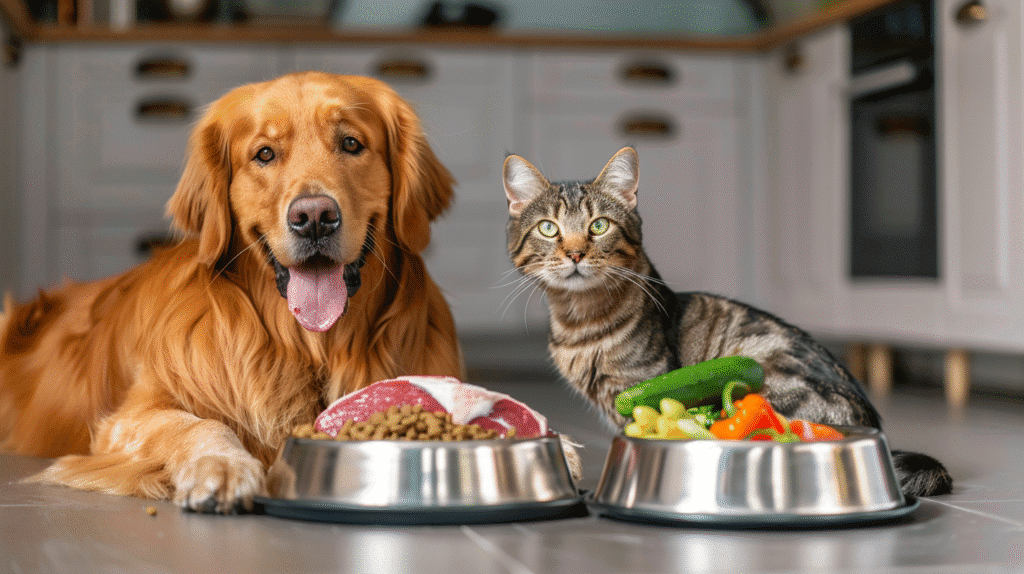Introduction
Feeding your pets isn’t just about filling their bowls—it’s about ensuring they get the right nutrients to live a healthy, happy, and long life. Just like humans, dogs and cats require a balanced diet tailored to their unique needs. An imbalanced diet can lead to obesity, nutrient deficiencies, or chronic illnesses.
In this guide, we’ll explore the key components of a balanced diet for dogs and cats, common feeding mistakes, tips for choosing the right food, and how to make healthy changes without upsetting your pet’s tummy.
Why a Balanced Diet Matters for Pets
A balanced diet is essential for:
- Energy and vitality – Keeps pets active and playful.
- Immune system support – Helps fight off illness.
- Healthy skin and coat – Reduces shedding and promotes shine.
- Strong bones and muscles – Supports growth and mobility.
- Longevity – A well-fed pet often lives longer and healthier.
Without proper nutrition, pets can suffer from weight problems, digestive issues, joint problems, and even reduced life expectancy.
Core Nutritional Needs for Dogs and Cats

1. Proteins
Proteins are essential for muscle development, tissue repair, and immune function.
- Dogs: Need both animal and plant proteins, but animal proteins should dominate.
- Cats: Obligate carnivores—require high amounts of animal protein.
Sources: Chicken, turkey, fish, beef, eggs.
2. Fats
Healthy fats provide concentrated energy, aid in nutrient absorption, and keep coats glossy.
Sources: Fish oil, chicken fat, flaxseed oil.
3. Carbohydrates
While not essential for cats, carbs provide quick energy for dogs.
Sources: Sweet potatoes, brown rice, oats, barley.
4. Vitamins and Minerals
- Vitamin A for vision and immune function.
- Vitamin D for calcium absorption.
- Calcium & Phosphorus for bones and teeth.
- Taurine (especially for cats) for heart and eye health.
5. Water
Hydration is a cornerstone of pet health. Always ensure fresh water is available.
Feeding Guidelines by Pet Type
Dogs
- Puppies: 3–4 meals/day.
- Adults: 2 meals/day.
- Seniors: 1–2 meals/day with lower calories.
Cats
- Kittens: 3–4 small meals/day.
- Adults: 2–3 small meals/day or free feeding if weight is controlled.
Commercial Food vs. Homemade Diets
Commercial Pet Food
Pros: Convenient, formulated for nutritional balance, long shelf life.
Cons: Quality varies—always check ingredient lists.
Homemade Diets
Pros: Fresh, customizable for allergies or sensitivities.
Cons: Requires careful planning to ensure balance—consult a vet or pet nutritionist.
Common Feeding Mistakes to Avoid
- Overfeeding – Leads to obesity and related diseases.
- Giving too many treats – Should be less than 10% of daily calories.
- Feeding inappropriate human foods – Some foods are toxic to pets.
- Ignoring age-specific needs – Nutritional needs change with life stages.
Transitioning to a Balanced Diet
- Step 1: Gradually mix new food with old food over 7–10 days.
- Step 2: Monitor for digestive changes.
- Step 3: Adjust portion sizes based on energy level and weight.
Special Diet Considerations
- Allergies: Opt for limited-ingredient diets.
- Senior Pets: Lower calories, joint supplements.
- Active Pets: Higher protein and fat.
Signs Your Pet’s Diet is Working
- Healthy weight.
- Shiny coat.
- Bright eyes.
- Good energy levels.
- Regular, firm stools.
Conclusion
A balanced diet is the foundation of a healthy and happy life for your pets. Whether you choose high-quality commercial food or a carefully crafted homemade diet, the goal is to meet all nutritional needs for their breed, size, and life stage.
